"That is the essence of science: ask an impertinent question,
and you are on the way to a pertinent answer."Jacob Bronowski (1908-1974), The Ascent of Man
"What difference does it make to the dead, the orphans and the homeless,
whether the mad destruction is wrought under the name of totalitarianism
or the holy name of liberty or democracy ?"Mahatma Gandhi (1869-1948), Non-violence in Peace and War, Vol 1, Ch 142
In our look at holarchic valuation we identified three questions to ask in order to clarify our viewpoint on any issue. First was determining relevant values and needs, second was identifying our beliefs and third evaluating the difference these made to our behaviours. In this essay we will look especially at the importance of this third question in clarifying the synergic or dysergic strategies employed by groups of people, the positive and negative effects of their actions upon the whole. But we will also look at how we can expand our valuation methodology to allow us to evaluate such strategies, to map 'how we value' to 'how we behave'.
Much thought, within the field of philosophy, considers questions such as "does God exist ?", "is the world 'real' ?", "can there be 'objective' morals ?". All these sorts of question presuppose that the answer makes a difference, that it is important to 'know' the truth, yet in general this is rarely the case. Our behaviours do not depend upon what is 'real' (which cannot be determined with absolute certainty in any situation) but upon what we believe is real, and crucially this belief need have no connection to knowledge as traditionally understood, i.e. to scientifically based 'fact'. In this sense all sorts of abstract level values take the stage, and we can say that is it these, not any 'factually' based values, that have pride of place as the actual definers of human activity worldwide, especially in the realms of politics and religion.
If someone believes that a loving and just 'God' will reward them in the afterlife for the mass murder of 'infidels' (an irrational view to most people - since such an action is not 'loving' and a reward would not therefore be 'just'), then this would not be changed by our knowledge that the belief is groundless, or even what the person says they believe, which in today's world is so often a blatant lie - that person will still behave the same, the view will still make the requisite difference (in this case a very dysergic or negative-sum one). In all cases, what is important is not what we actually believe but what it causes us to do, and in evaluating the effects of our actual actions we take a necessary step in establishing a practical science of values so that we can evaluate our behaviours regardless of their connection to materialistic or logical 'facts'. This requires that we attempt to link together the various aspects that form the coevolutionary whole in which we live our lives.
Good and evil (a systemic valuation if ever there was one) may appear, like all systemic distinctions, to denote 'things', objects or characteristics that we can either possess or not. Yet this is very simplistic, these terms are abstract generalities usually used to 'judge' (a process) a whole gamut of behaviours. These
are all intertwined, multiple choices leading to multiple trajectories affecting multiple values. We
'average' these (sum-over) in determining whether we label a person as 'good' (their actions generally leading to positive results) or 'evil' (their actions leading, always it is being implied, to negative results) - both labels being of course from our perspective only ! Thus we label collections of 'processes', not collections of 'things' (which being static don't act and thus cannot be 'judged').
But why do we act at all ? Because we believe that we can change something. And why should we desire to change something ? Because the 'world as is' is unsatisfactory in some way, we can imagine a better situation. Better in what sense ? In the sense that what we value can be enhanced by our action. And what do we value ? We value our existence, our social life, our interests, what we need to fulfil our humanity. It is in this wider context that we should consider on what basis we choose to act, and of course these values include our philosophical and ethical beliefs.
Much discussion on ethical grounds takes the view that we can either have a morality of rules (where the actual results don't matter - a concentration upon theory) or a morality of consequences (where the motives don't matter - a concentration upon practice), but such divorces of mind and matter just will not suffice. Any practical form of belief must be based on results (although of course we can hold some beliefs that do not cause us to act, so have no direct consequences - although if they cause us actively not to act then this will not be the case). We cannot live our lives in a situation where what we do continually has results that we don't expect, this form of chaos would be a recipe for insanity, so we must rationalise our conscious behaviours in some way. In general we seem to employ reductionist methods, we discard any 'inconvenient' facts or dimensions, retaining only those aspects of our situation that fit our 'belief'. In this way, by taking our cut-down 'map' to be the same as the whole 'territory' we are able to convince ourselves that we are acting 'correctly' in any situation, that we are 'in the right'.
It is here that understanding our self-delusions needs the help of others. It is very difficult to see the wider picture from within a viewpoint that excludes most of it ! Blinkered one-dimensional viewpoints, whether within science or religion, are the norm rather than the exception today. In almost any discussion, what is left out is far more significant than what is included. Humans are relatively poor at looking at alternatives, at 'seeing the other side of the picture', and when we realise that in today's multicultural world there is often not just one 'other side' but very many of them, then the problems are compounded. It is in this area that the need for a more formal method of analysing these issues and synthezising an objective whole is recognised.
Formalising value interactions needs a great deal of work, since these associations are deeply embedded within our subconscious neural network and usually are invisible to 'consciousness'. Yet by considering these in a rational way we can often clarify, in any situation, which values we think are important and whether they mutually support or oppose each other. Thus we can get a 'feel' for the likely dynamics of the situation, and it is these dynamics, how the values play out over time, that is important here, not their static structure.
Previously we identified four aspects missing from science, alternatives, choices, values and fitnesses - those operations relating to possibility, variability, usefulness and context. We can expand on this now. Five aspects seem involved in our analysis here. Firstly there is our knowledge of which values exist. This relates to Level 1, our 'systemic' valuation mode. The second aspect relates to measurements of their importance, our Level 2 'extrinsic' valuation mode. The third aspect relates to the Level 3 'intrinsic' values of the wholes involved, and here we can distinguish between inanimate wholes (like rocks) and animate (teleological) ones like people. Finally we can recognise that these all connect and coevolve, our Level 4 'holarchic' valuation mode. We can indicate this in a short table:
| Know | Choose | Identify | Create | Grow |
| Level 1 | Level 2 | Level 3O | Level 3H | Level 4 |
In the establishment of such valuations we see the effects of our early human neural development, starting with no knowledge (Mode 0), we initially make simple distinctions (Mode 1), we then gain the ability to make comparisons (Mode 2), followed by identifying objects as valid in themselves (Mode 3O), eventually recognising other humans as having autonomy in themselves (Mode 3H) and, sometimes, coming finally to recognise that there is a 'interdependent' whole (Mode 4).
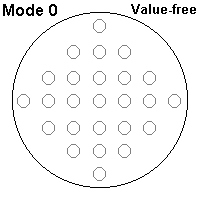
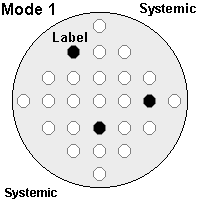
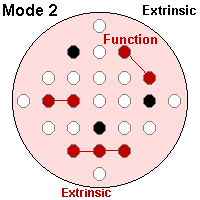
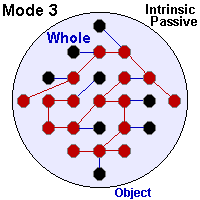
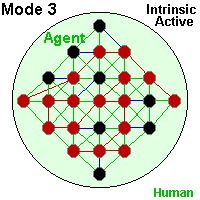
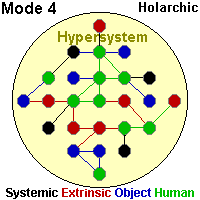
The following picture denotes a single human (Level 3H) located within a Level 4 environment. Each concept within the higher-level mind of the human, which can be L1, L2 or L3O, is in itself comprised of other levels, which are themselves comprised of other levels and so on, until we reach the 'real world' which is not so divided or categorised. This hierarchical and fractal structure is imposed upon the world, we decide how, where and when to make these distinctions, to establish or construct these 'borders', just as we do for those surrounding what we choose to call 'nations'.
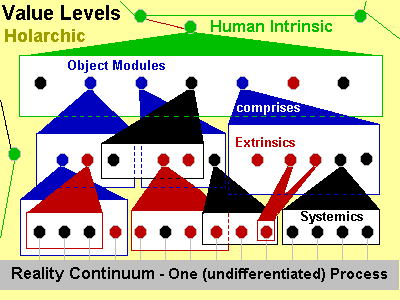
The temporal development of mind can be portrayed in a different manner, one that emphasises three dynamics or trajectories. In the first we don't develop any 'rational' abilities, we live in the 'now', as holistic beings - part of the whole (even identifying with it as in 'New Age' thinking) yet not understanding it (largely an animal behavioural pattern). In the second we investigate 'scientifically' part of this whole, we 'specialise', becoming 'expert' in some narrow field yet remain ignorant of the part our supposed expert area plays in the wider world. The third concentrates on our growth or personal development, recognising that we must progress through the various levels and not get 'stuck' or fixated upon any one of them. Different levels of wisdom relate to different levels of thought and valuation focus, from the categorical philosophical (Level 1), via reductionist scientific (Level 2), through materialistic (Level 3O), and humanistic (Level 3H), to synergic (Level 4) - each of wider scope and accuracy than the last.
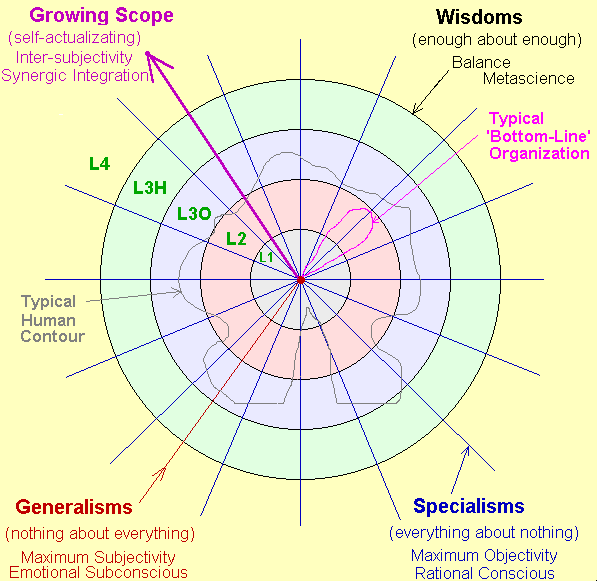
Mapping any human onto this picture we would expect that the average man-in-the street would correspond to a misshapen amoeboid-like circle close to the centre, maybe with 'pseudopodia' extending out to areas of especial interest (e.g. hobbies). A specialist would be a lobe roughly centered around a radial, of length and width corresponding to their depth of knowledge and breadth of interests. An educated 'layman' would be a rough circle further out, corresponding to greater general knowledge, understanding and critical thinking - maybe with 'valleys' related to 'holes' in their knowledge or dogmatisms (a guess at a typical contour is illustrated - this gives a sort of 'right-hemisphere' display). The 'thing' bias expected, even from knowledgeable thinkers today, corresponds to the centering around Level 3O, but we also show a typical organizational contour, in this case limited to a Level 2 understanding - that 'money' focus. We should recognise that these contours will be dynamic not static, expanding and contracting as the person (and perhaps even the organization) gains knowledge, forgets knowledge and changes interests, structure would be then expected at all levels of detail - the fractal like nature of such processes should be made clear. An enlightened person, ideally, would exist outside the outer border, in the Level 4 region, full of understanding of all areas and interactions - but we can see, in context, how demanding this would be in practice, especially if we now try to map real organizations and people onto such a picture.
In recent work, Anthony Judge and the UIA proposed a matrix of relationships covering human activities,
these being explained in supporting documents.
| Matrix columns | Matrix levels/rows | |
| 9 | Condition of the whole | Experiential (modes of awareness) |
| 8 | Environmental manipulation | Experiential (values) |
| 7 | Resource redistribution | Innovative change (context strategies) |
| 6 | Communication reinforcement | Innovative change (structure) |
| 5 | Controlled movement | Concept formation (context) |
| 4 | Contextual renewal | Concept formation (structure) |
| 3 | Differentiated order | Social action (context) |
| 2 | Organized relations | Social action (structure) |
| 1 | Domain definition | Biosphere |
| 0 | Formal pre-conditions | Cosmophere/Geosphere |
In this framework 10 rows classified human activities, under such headings as Fundamental sciences (physics), Life (biology) and Society (humans), the 9th row corresponds to our overall focus here, and thus is not treated as a separate 'subject', but more as a meta-view. Associated with each of these rows were 10 columns going from left to right, moving from concrete to more abstract ideas and behaviours. One of the features of this approach was to highlight the dualism of human behaviours, that alternation between opposites (counterbalancing of functional complements) that forms so much a part of our human dynamics. In this way we see the alternation between a static 'things' approach, and a dynamic 'process' approach up the rows (structure/context); and a dynamic across the columns related to expansion and contraction (chaos/order). We can compare this matrix with our own illustrative classification using 6 rows and (mostly) 9 columns:
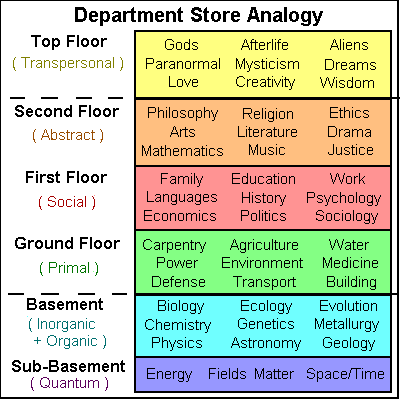
We attempt here to relate these ideas to our identification of valuation modes and modes of awareness or thinking, illustrated by the following chart:
To expand our valuation methodology to encompass all 10 columns of the UIA model suggests that we need to follow the lead given by our earlier illustration and break down our valuation levels each into two parts, related to objects and agents (which we can regard as 'quantitative' versus 'qualitative' classifications - 'things' versus 'processes').
| Level 5 | Abstract - other-world/ivory-tower thought, pure fantasy or imagination |
| Level 4H | Synergic - multicultural, holarchic applied to humans (multi-level fractal) |
| Level 4O | Ecological - web of life, holarchic applied to objects (multi-level fractal) |
| Level 3H | Humanistic - intrinsic applied to humans (one-level fractal) |
| Level 3O | Materialistic - intrinsic applied to objects (one-level fractal) |
| Level 2H | Psychometric - extrinsic applied to humans |
| Level 2O | Experimental - extrinsic applied to objects |
| Level 1H | Dogmatic - systemic applied to humans |
| Level 1O | Classificational - systemic applied to objects |
| Level 0 | Value-free - traditional physical science belief |
In the following diagram we see these levels and subject classifications arranged in a circle. As we move from the centre outwards we move from 'hard' static viewpoints to progressively 'softer', more fuzzy and dynamic, ones for each subject. As we move clockwise around the circle we move from fundamental physics via the various 'emergent' levels expected from a complexity viewpoint, returning eventually to the start where philosophy meets physics again. The adjacent subjects interact in a standard, bidirectional, upward/downward causation dynamic.
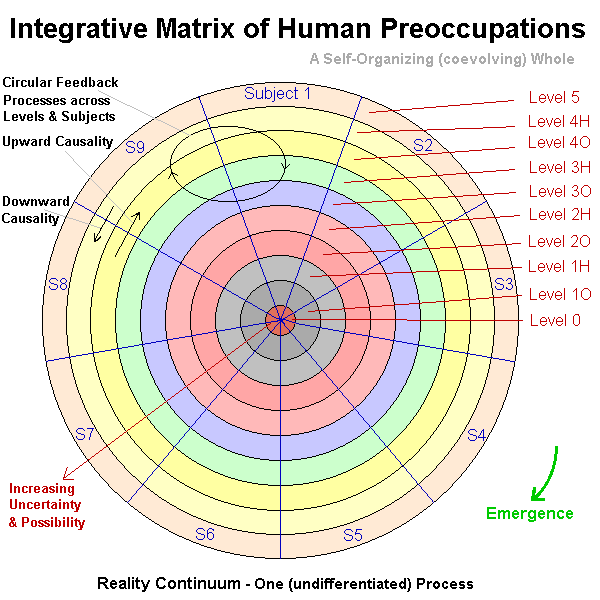
We need to consider this move from 'hard' actuality to 'soft' possibility more closely. All 'hard' science is a simplification, the greater the simplification the lower the valuation level becomes. Despite our use of a Level 0, to reflect the 'belief' that science is value-free, we can see that in practice it is not. All classifications, e.g. trees, suns, rocks, are systemic valuations and thus Level 1; if we allow variability, e.g. planetary orbits, then we move to extrinsic valuation, Level 2. As we widen our focus, and take-in wholes, e.g. 'organisms', we use intrinsic valuation, Level 3; and once we add in many wholes, e.g. in ecology, we must take an holarchic valuation perspective, Level 4. From a fractal stance, this valuation progression happens in all fields, and at all levels of space and time (whether we choose to label it subjective 'valuation' or just objective 'description' - the two are never disjoint).
In this sense, we can see that attempts to 'pigeonhole' any subject in any 'box' are invalid, and that all subjects can, potentially, extend fractal-like into any adjacent (or even non-adjacent) subject or time dimension (as illustrated with our previous contour). Thus we can say that what is often called 'physics envy' by the human sciences is an attempt to disvalue their own field and reduce a subject needing a Level 4 perspective to an oversimplified and invalid Level 1 or 2 valuation - in other words a pretence to have 'certainty' in subjects that are inherently 'unpredictable' ! Such deceits are not science, but certainly qualify as a form of self-delusion... This form of diagram clearly devotes little space to lower levels (correctly, since their possibilities, i.e. their state space, is correspondingly less), yet it is difficult to map, in a visible way, typical (close to origin) human views onto such a space. With modern technology however it may be possible to topologically distort this picture, compressing the outer layers and expanding the inner, so creating a dynamic map that expands and contracts to match and display the interests of any particular person or organization - expanding their 'contour' to suitably fill the whole space.
The limitations of mapping a 4 dimensional reality onto a 2 dimensional picture are clear. Can we do better ? Luckily computers are not restricted to 2 dimensions and can model realities of any number of dimensions. Creating a 3-D extension of our map may be quite easy and would take the form of a sphere. Here the radius would be the valuation axis, from Level 0 at the centre (empty!) out to Level 5 at the surface. In this model the Longitudes and Latitudes would correspond directly to the UIA matrix, and this would perhaps be better overall. Computers can quite easily compute sections or slices through such a whole (a projection from several dimensions onto 2, called a 'Poincaré section' in dynamical theory) so we could dynamically access many different views. Yet this model still largely ignores time, that 4th dimension of evolution or growth. Maybe we could add this too to our computer model, reflecting better the true nature of our dynamical behaviours - a model that bears quite a resemblance to a 3D plasma controlled and shaped by 'social fields'. After all, it is the difference between today and tomorrow which is central to all human action, between what is 'permissible' or is not, whether we can 'escape' our containment ? An interesting analogy here is to 'real-time' brain scans, these colourful 2D maps of thought may correspond to slices through our 'contour in 3D' - giving the 2D dynamics of our personal 'intrinsic valuation'. Is the brain built in the same centre-out mode that we described - from reptilian (Level 0/1/2), via limbic (L3), to neocortical (L4/5) ? An interesting possibility.
Yet there remains the possibility that we need yet another dimension. As in 2-dimensional "Flatland" we cannot get from point A to point C without going through point B - it is in the way.  But in three dimensions we can jump from A to C (via our 'wormhole' in good Star Trek or Babylon 5 fashion). Do we then need a 5th dimension for our model - after all we have arguments between 'scientists' and 'religious fundamentalists' which bypass all the humanity in the centre (and, one is tempted to say, between their ears also...) ! If we can link any part of the model to any other part, then once again we have a fractal structure evident, detail on all potential scales. To even begin to see in this manner, to understand this 'whole' we need to take a step back and engage a metaview, even if the validity of such 'metanarratives' is rubbished by those of a postmodern persuasion. As we have discovered however, both absolutism and relativism are simply the ends of a continuum, and to treat either as 'true' and the other as 'false' is simply to make a Level 1 disvaluation of a Level 4 totality, and despite all our differences humans do all have their 'humanity' in common - that isn't relative.
But in three dimensions we can jump from A to C (via our 'wormhole' in good Star Trek or Babylon 5 fashion). Do we then need a 5th dimension for our model - after all we have arguments between 'scientists' and 'religious fundamentalists' which bypass all the humanity in the centre (and, one is tempted to say, between their ears also...) ! If we can link any part of the model to any other part, then once again we have a fractal structure evident, detail on all potential scales. To even begin to see in this manner, to understand this 'whole' we need to take a step back and engage a metaview, even if the validity of such 'metanarratives' is rubbished by those of a postmodern persuasion. As we have discovered however, both absolutism and relativism are simply the ends of a continuum, and to treat either as 'true' and the other as 'false' is simply to make a Level 1 disvaluation of a Level 4 totality, and despite all our differences humans do all have their 'humanity' in common - that isn't relative.
Questioning the basis of our behaviours is crucial if we wish to improve them. And if we do not wish to improve, as seems evident in so much of our society, then we must question why we have such static (and so often destructive) beliefs. The answer seems to relate to the way we value, and in this essay we have looked at the scope for expanding our horizons, and valuing in much more 'objective' and relevant ways. Here we deny, totally, that idea that science has 'no values' and recognise simply that those people promoting such views are self-delusional, and choose to exist only at valuation level 0. They need to grow, but so do we all, few of our institutions get beyond level 1 or 2, almost none exceed level 3 - that 'self-obsessed' modern delusion of 'disconnectedness'. Level 4 in both of its modes needs to connect also with Level 5, which usually exists in that divorced alter-ego associated with art and (far too often) 'academia', whether 'scientific' or not, a view which so often totally ignores the wider effects of its actions, even imagining (incredibly) that they have no effects because they are (supposedly, but so mistakenly) 'objective' ! A true understanding of Level 5 may relate to the Zen approach, where the whole contains all the parts, whilst remaining free of attachment to any of them, thus all our transformational possibilities remain open ('absolute limitlessness'), yet all of actuality still remains real - and this is what our 'matrix' picture could be said to depict.